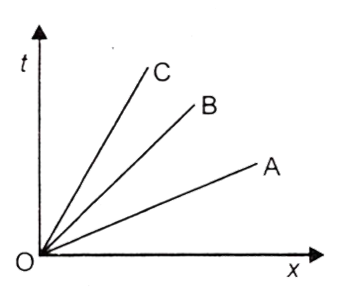 Multiple Choice Questions
Multiple Choice QuestionsThe focal length of the objective lens of a telescop is 50 cm. If the magnification of the telescope is 25 then the focal length of the eye-piece is:
12.5 cm
5 cm
2 cm
10 cm
Which one of the following forces is non-central and non-conservative?
Frictional force
Electric force
Gravitational force
Mechanical force
A.
Frictional force
Suppose there are two planets, 1 and 2, having the same density but their radii are R1 and R2 respectively, where R1 > R2. The accelerations due to gravity on the surface of these planets are related as:
g1 > g2
g1 < g2
g1 = g2
Can't say ayntihing
The Sun is seen little before it rises and for a short while after it sets. This is because of:
total internal reflection
atmospheric refraction
apparent shift in the direction of Sun
dispersion
1 dyne (a unit of force in CGS system) equals to:
103 g cm/s2
10-3 g cm/s2
105 kg m/s2
10-5 kg m/s2

The figure shown above gives the time (t) versus position (x) graphs of three objects A, B and C. Which one of the following is the correct relation between their speeds VA , VB and VC respectively at any instant (t > 0)?
VA < VB < VC
VA > VB > VC
VA = VB = VC ≠ 0
VA = VB = VC = 0

In the given velocity (V) versus time (t) graph, accelerated and decelerated motions are respectively represented by line segments:
CD and BC
BC and AB
CD and AB
AB and CD
Which one of the following statements regarding a thermos flask is NOT correct?
The walls of flask are separated by vacuum and made of glass which is a poor conductor of heat.
The glass walls themselves have shiny surfaces
The surface of inner wall radiates good amount of heat and the surface of outer wall absorbs some of the heat that is radiated from the inner wall.
The cork supports are poor conductors of heat
'Black hole' is a:
huge black star which has zero acceleration due to gravity on its surface
star which has moderate acceleration due to gravity on its surface
star which has collapsed into itself and has large acceleration due to gravity on its surface
star which has collapsed into itself and has large acceleration due to gravity on its surface
The formula for conversion between Fahrenheit and Celsius is °F = X + ( 1.8 x °C) What is factor X?
32
22
98
42
